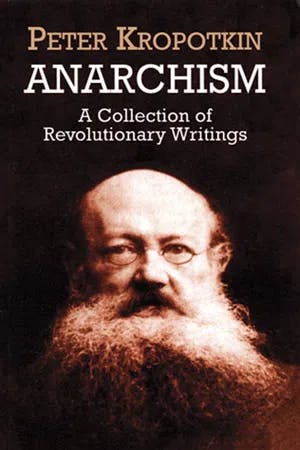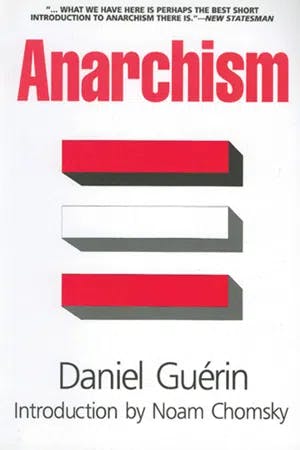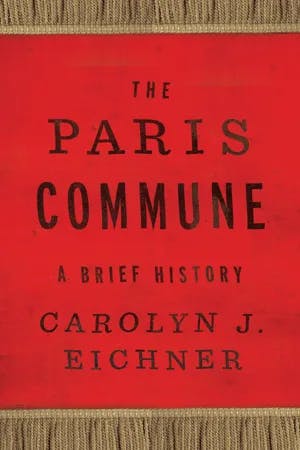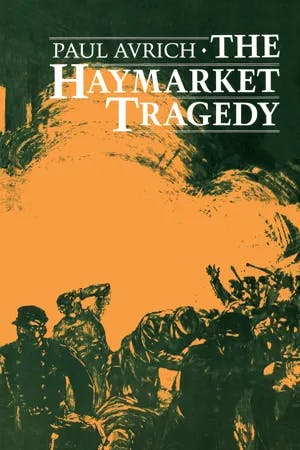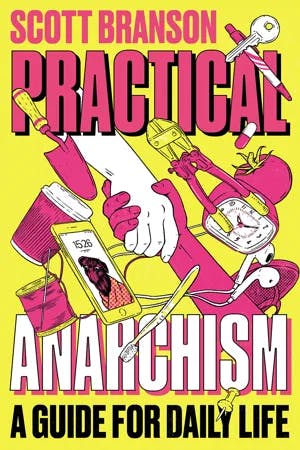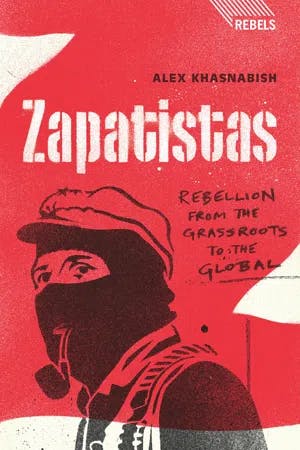What is Anarchism?
MA, Sociology (Freie Universität Berlin)
Date Published: 07.09.2023,
Last Updated: 07.09.2023
Share this article
Defining anarchism
When you hear the term anarchy, it likely conjures images of violence and chaos. Similarly, the idea of having no government, one of anarchism’s central tenets, probably sounds extreme and infeasible. However, proponents of anarchism would argue that it is a highly misunderstood political ideology that often refers to more mundane things like our capacity for cooperation with others in our daily lives. So, how might anarchism be defined on its own terms? As Roger N. Baldwin describes it in the preface to Anarchism,
anarchism is an ever-present working principle of growth toward larger freedoms, and in all social activity. If means create ends, no really free society is possible without the constant building up of habits of freer relationships, of increased individual liberty, and of larger independence for all social groups. (Baldwin, in Kropotkin, 1927 [2012])
Peter Kropotkin
anarchism is an ever-present working principle of growth toward larger freedoms, and in all social activity. If means create ends, no really free society is possible without the constant building up of habits of freer relationships, of increased individual liberty, and of larger independence for all social groups. (Baldwin, in Kropotkin, 1927 [2012])
Anarchism is an umbrella term that refers to a wide array of principles and practices that resist a static definition. Some of its core characteristics, however, include the rejection of unjustified hierarchical authority in lieu of more horizontal power structures, mutual cooperation, and direct democratic decision making. It holds freedom, autonomy, and the capacity for humans to self-organize as some of its highest values.
Moreover, the history and scope of anarchism is vast and complex — spanning across the globe and existing in various forms over the course of history. This study guide offers an overview of key figures and events associated with the classical anarchism of the 19th and early 20th centuries, as well as contemporary anarchist practices.
Classical anarchism
Prior to the emergence of empires and nation-states, humans have self-organized and provisioned in the absence of centralized governmental authorities. In many ways, anarchists argue that these kinds of small-scale, decentralized forms of living amongst each other without abiding by formal laws, bureaucracy, or police constitute early forms of anarchism. Yet, the concept emerged as a coherent political philosophy during the late 19th and early 20th centuries, a time period known as the “Golden Age of Anarchism.” While it is not possible to summarize all the forms of anarchism that flourished during this time period — including in places like Asia, Latin America, and among indigenous peoples — there are a few central figures and historical examples most closely associated with the classical anarchist canon.
Key figures
Pierre-Joseph Proudhon (1809-1865)
Many attribute the origin of anarchism as a formal political ideology to the French philosopher, Pierre-Joseph Proudhon. His critiques of capitalism and governmental authority laid the foundation for much subsequent anarchist thought. For Proudhon, the oppressive nature of these forces was derived from the existence of private property. As Proudhon argues in What is Property? (1840),
The purchaser [of property] draws boundaries, fences himself in, and says, ‘This is mine; each one by himself, each one for himself.’ Here, then, is a piece of land upon which, henceforth, no one has a right to step, save the proprietor and his friends; which can benefit nobody, save the proprietor and his servants. Let these sales multiply, and soon the people—who have been neither able nor willing to sell, and who have received none of the proceeds of the sale— will have nowhere to rest, no place of shelter, no ground to till. They will die of hunger at the proprietor's door, on the edge of that property which was their birthright; and the proprietor, watching them die, will exclaim, ‘So perish idlers and vagrants!’ (1840)
Pierre-Joseph Proudhon
The purchaser [of property] draws boundaries, fences himself in, and says, ‘This is mine; each one by himself, each one for himself.’ Here, then, is a piece of land upon which, henceforth, no one has a right to step, save the proprietor and his friends; which can benefit nobody, save the proprietor and his servants. Let these sales multiply, and soon the people—who have been neither able nor willing to sell, and who have received none of the proceeds of the sale— will have nowhere to rest, no place of shelter, no ground to till. They will die of hunger at the proprietor's door, on the edge of that property which was their birthright; and the proprietor, watching them die, will exclaim, ‘So perish idlers and vagrants!’ (1840)
In other words, Proudhon believed that when wealthy people own things like land, the means of production, or natural resources it excludes others from utilizing them in order to meet their basic needs. This paves the way for exploitation and social inequality.
Proudhon held a vision of society organized around mutual aid, cooperation, and reciprocity instead of despotism, scarcity, and exploitation. He advocated for the use and ownership of property solely according to people’s needs, and for mutualism, the idea that workers ought to receive compensation for the full value that they produce.
Mikhail Bakunin (1814-1876) & Pyotr Kropotkin (1842-1921)
Perhaps two of the most well-known anarchist thinkers emerged in response to the oppressive regime of Czarist Russia:Mikhail Bakunin — a follower of Proudhon — and Pyotr Kropotkin. Their ideas were influential in the makings of the Bolshevik Revolution, though the anarchists represented a notable splinter faction from the socialist ideologies associated with the Red Army and the doctrine of Marxism-Leninism.
Alongside Karl Marx, Bakunin was a member of the first international, an organization meant to bring together different socialist, communist, and labor movements. Yet, Bakunin’s views stood in contrast to Marx’s on some key topics, which became the impetus for the anarchist split from the organization. In particular, Bakunin took issue with the socialist idea that following a revolution, the state apparatus could be reappropriated as a vessel for distributing wealth and power back to the common people. Indeed, Bakunin was highly suspicious of the state in any form, as he famously argued,
Take the most radical of revolutionaries and place him on the throne of all [of] Russias or give him dictatorial powers … and before the year is out he will be worse than the Czar himself. (Bakunin, quoted in Guérin, 1970)
Daniel Guérin
Take the most radical of revolutionaries and place him on the throne of all [of] Russias or give him dictatorial powers … and before the year is out he will be worse than the Czar himself. (Bakunin, quoted in Guérin, 1970)
Thus, Bakunin repudiated the revolutionary socialist idea of taking over the state in lieu of the Czar, believing that the very existence of the state itself would corrupt and usher in a new, oppressive ruling class. Instead, he advocated for liberation via decentralized, self-organization of workers.
A generation later, Kropotkin was a prominent advocate for anarcho-communism known for his emphasis on practices of mutual aid and cooperation as the core of what gave humans an evolutionary advantage. He argued that in the absence of capitalism and the external authority imposed by governments, people revert to their naturally altruistic ways. He backed up this view in his work, “Mutual Aid: A Factor of Evolution,” where he observed that,
those animals which acquire habits of mutual aid are undoubtedly the fittest. They have more chances to survive, and they attain, in their respective classes, the highest development of intelligence and bodily organization… mutual aid is as much a law of animal life as mutual struggle, but that, as a factor of evolution, it most probably has a far greater importance. (1902 [2017])
Pierre-Joseph Proudhon, Michael Bakunin, Peter Kropotkin, Emma Goldman, Lysander Spooner & Benjamin R. Tucker
those animals which acquire habits of mutual aid are undoubtedly the fittest. They have more chances to survive, and they attain, in their respective classes, the highest development of intelligence and bodily organization… mutual aid is as much a law of animal life as mutual struggle, but that, as a factor of evolution, it most probably has a far greater importance. (1902 [2017])
He concluded that anarchism was not only aligned with humans’ natural tendencies but that it also constituted the most ethical form of social organization, as it enabled humans to best manage their own affairs at the local and individual levels. Therefore, he advocated for anarcho-communist forms of social organization based on mutual aid and collective ownership of property. His thinking has been highly influential on subsequent anarchist theory and practice.
Emma Goldman (1869-1940)
Emma Goldman was a prominent anarchist and feminist, particularly in North America, where she emigrated from Russia in 1885. Known especially for her writing and public speaking, she was co-editor of the anarchist paper journal, Mother Earth, as well as the anthology, “Anarchism and Other Essays.” In addition to being a labor rights activist and outspokenly against WWI, she was also a staunch advocate for women’s autonomy and liberation from patriarchy as she believed this to be a central dimension of bringing about anarchist revolution.
In response to the women’s suffrage movement, Goldman’s anarcha-feminist ideas come to the fore in her 1911 speech, “Woman Suffrage,”
[Women] can give suffrage or the ballot no new quality, nor can she receive anything from it that will enhance her own quality. Her development, her freedom, her independence, must come from and through herself. First, by asserting herself as a personality, and not as a sex commodity. Second, by refusing the right to anyone over her body; by refusing to bear children, unless she wants them; by refusing to be a servant to God, the State, society, the husband, the family, etc. (quoted in Red Emma Speaks, 2012)
Alix Kates Shulman
[Women] can give suffrage or the ballot no new quality, nor can she receive anything from it that will enhance her own quality. Her development, her freedom, her independence, must come from and through herself. First, by asserting herself as a personality, and not as a sex commodity. Second, by refusing the right to anyone over her body; by refusing to bear children, unless she wants them; by refusing to be a servant to God, the State, society, the husband, the family, etc. (quoted in Red Emma Speaks, 2012)
Goldman believed women’s liberation could not come through current political structures, but was deeply intertwined with their abolition.Moreover, her anarchism was intersectional in other ways, too, as she called for the acceptance of same-sex relationships, gender nonconformity, and the rights of immigrants.
Historical examples of anarchism
Paris Commune (1871)
The Paris Commune is one of the most famous of the early anarchist experiments. During the Franco-Prussian War (1870–71), the French National Guard had been defending Paris, and working-class radicalism was growing among the soldiers inside the walls of the city. With the establishment of the Third Republic at the end of the war — marking France’s defeat — the national guard refused to accept the new government. Instead, they seized control of the capital for 72 days and established the Paris Commune.
Over the course of its brief existence, members of the Paris Commune implemented a number of anarchist principles and practices that centered aspirations of the working class. They organized direct democratic elections and established the separation of church and state. They also instituted equal pay for women and their equal political participation. Unoccupied housing was also seized to be allocated to the homeless. In addition, free schooling and legal services were made available to all. Moreover, people had access to communal kitchens, solidarity funds, and workers’ cooperatives.
After about two and a half months, however, the Commune was brutally crushed in a bitter struggle resulting in the widespread and indiscriminate executions of those residing within it at the hands of the French military. Yet, as Carolyn J. Eichner argues,
The Commune stands as a critical and pivotal moment in nineteenth-century history, as the linchpin between revolutionary pasts and futures, and as the crucible allowing glimpses of alternate possibilities. Upending hierarchies of class, religion, and gender, the Commune emerged as a touchstone for the subsequent century and a half of revolutionary and radical social movements. (2022)
Carolyn J. Eichner
The Commune stands as a critical and pivotal moment in nineteenth-century history, as the linchpin between revolutionary pasts and futures, and as the crucible allowing glimpses of alternate possibilities. Upending hierarchies of class, religion, and gender, the Commune emerged as a touchstone for the subsequent century and a half of revolutionary and radical social movements. (2022)
Indeed, the Paris Commune demonstrates the capacity of people to self-organize in their own interests as well as the brutal state repression that often follows any experiment in anarchism.
The Haymarket Affair (1886)
The Haymarket Affair refers to the Chicago labor protests that took a violent turn in Haymarket Square on May 4th 1886. Protestors had gathered in response to police brutality in suppressing strikes on the previous day, which resulted in the death of one protester and the injury of several more. As the protest was coming to an end, a bomb was thrown by an unidentified assailant. Seven police were killed by the bomb, and the situation erupted into chaos, as both police and protestors retaliated by firing into the crowd, resulting in the death and injury of civilians and police alike.
While anarchists of this time period were associated with “propaganda of the deed,” including violent tactics like political assassinations, the Haymarket Affair represents the complexity of anarchism’s infamous association with violence and chaos. This is because the event was used as an opportunity by the local government to punish known anarchists and quell the labor struggles, which had been escalating in intensity and increasingly threatening the status quo in the Chicago industrial sector and beyond. Eight prominent anarchist figures and labor organizers — the majority of whom were foreigners — were tried and four were sentenced to death for conspiracy and murder, even though it remains unclear whether they were the ones involved in the throwing of the bomb.
The Haymarket Affair had a major impact on how anarchism was perceived in the United States, as anarchism became more closely associated with foreign terrorism in the public perception. As Paul Avrich summarizes it in The Haymarket Tragedy,
anarchism became identified with foreigners and subversion. It was everywhere execrated as an alien doctrine which aimed to undermine American values, and the stereotype of the anarchist as a foreign-looking, black-cloaked, bomb-wielding fanatic, dedicated to chaos and destruction, became firmly established during this period. (2020)
Paul Avrich
anarchism became identified with foreigners and subversion. It was everywhere execrated as an alien doctrine which aimed to undermine American values, and the stereotype of the anarchist as a foreign-looking, black-cloaked, bomb-wielding fanatic, dedicated to chaos and destruction, became firmly established during this period. (2020)
Simultaneously, it also further radicalized many leftist activists who believed the trials to be unjust and held them as examples of government repression and fear mongering in line with their own interests. The events of the Haymarket Affair continue to be a rallying cry for workers’ struggle and marked the creation of International Workers Day.
The Spanish Civil War (1936-1939)
The Spanish Civil War became the site of another prominent experiment in anarchism. In fact, anarchists played a central role in resistance against the fascist forces of Francisco Franco during the war through violent clashes and other sporadic forms of guerilla resistance. They often did so under the banners of the anarcho-syndicalist labor unions of CNT (Confederación Nacional del Trabajo) and the FAI (Federación Anarquista Ibérica). Moreover, several variations of anarchism emerged throughout the country during this time. These included peasant anarchism in rural regions like Andalusia and anarcho-syndicalism in urban areas like Barcelona.
Morris Brodie observes in Transatlantic Anarchism during the Spanish Civil War and Revolution, 1936-1939 (2020),
the Spanish anarchist movement was presented with an opportunity, arguably unequalled before or since, to rid itself of the state forever. […] a The Spanish anarchist movement now had the chance to practise what they had been preaching for decades. The result, to quote Noam Chomsky, was ‘spontaneous, widespread, but unconsummated social revolution’. (2020)
Morris Brodie
the Spanish anarchist movement was presented with an opportunity, arguably unequalled before or since, to rid itself of the state forever. […] a The Spanish anarchist movement now had the chance to practise what they had been preaching for decades. The result, to quote Noam Chomsky, was ‘spontaneous, widespread, but unconsummated social revolution’. (2020)
As part of this social revolution, anarchists established collectives, communes, and effectively organized industries as syndicates where they operated entirely under workers’ control. As many as 8 million Spanish citizens participated, which was more than a third of the country’s population at the time.
Yet, the social revolution was itself marred by factionalism and counterinsurgency — by communists both within Spain and from the Soviet Union itself — who believed in the necessity of a centralized state apparatus. Furthermore, once Franco ascended to power the anarchists were targeted by the state and often executed en masse. As the world became embroiled in World War II, the defeat of the Spanish anarchists marked the end of the Golden Age of Anarchism.
Contributions and legacy of classical anarchism
As we have seen in these experiments in anarchism, anarchists have been subject to state repression because their ideas represent an existential threat to more conventional forms of government and industry. Yet, the question of whether anarchism’s reputation for being linked to violence and terrorism is justified continues to be hotly debated. Simultaneously, such historical examples continue to serve as a rallying cry for anarchists and other leftist groups to this day.
Though short-lived they demonstrated that other possibilities exist for social organization. Some specific contributions of classical anarchist theory and practice include:
- A challenge to private property, authoritarianism, and capitalism
- An emphasis on mutual aid, self-organization, and cooperation
- Alternative modes of organization predicated on practices of consensus, direct democracy, and non-hierarchical decision making
Now, let’s turn to an exploration of contemporary anarchism — which bears important lineages but also decisive breaks from the classical anarchist canon.
Contemporary anarchism
The range of anarchist practices has only dovetailed since the Golden Age of Anarchism. Anarchist influences abound in examples spanning from the punk movement and the production of feminist zines to squatting, hacktivism and other culture jamming activities. While contemporary anarchism draws upon many of the same major tenets such as the rejection of authority, decentralization, and self-organization, contemporary anarchists tend to resist association with a static political ideology or canon of thinkers from the past. Instead, they seek to live anarchism in the present via tangible practices, and to bring about glimpses of what life could be like in the absence of governments, private property, and other forms of exploitation.
Key concepts
In contemporary times, there is a vast range of anarchist concepts and practices that are associated with anarchism. These can be roughly organized around a rejection of our current capitalist economic system, an emphasis on direct action, and direct-democratic decision making. Crucially, many contemporary anarchists emphasize that anarchism is more about practices than whether people explicitly identify themselves as anarchists.
Direct action
Anarchists of today often use methods of direct action to reach the wider public and reveal the systems of dominance we tend to take for granted. As Scott Branson explains in Practical Anarchism, direct action affords people the possibility to
imagine a breaking into the imposed social order of hierarchy of a different time and space, the irruption of anarchism in the midst of normal life. (2022)
Scott Branson
imagine a breaking into the imposed social order of hierarchy of a different time and space, the irruption of anarchism in the midst of normal life. (2022)
Direct action might include protests, strikes, or blocking highways to expose the repressive role of the police in quelling unrest, or to demonstrate how the interests of corporations take precedence over those of regular people. While the subject of violence as a valid means of protest is debated among anarchists, many anarchists are also tolerant of the destruction of private property in protests. Yet, anarchists also are known to use more playful, carnivalesque kinds of protest to delegitimize the systems of power they are resisting. These could include wearing exaggerated and satirical costumes to poke fun at politicians, police, or CEOs as a way of subverting their dominance.
Anti-capitalism
Anarchists today generally reject the existing economic relations of capitalism. In line with the Proudhonist tradition, leftist anarchists argue that the existence of private property leads to exploitation and domination. Instead, they seek other ways of provisioning and distributing goods and services outside of market relations. For example, they are often advocates of mutual aid networks where people can donate money and goods directly to those in need. In addition, they often favor DIY approaches to the provisioning of resources such as community gardening and skill-sharing.
Here it is also worth mentioning, that in contrast to leftist anarchists, libertarian anarchists who focus more on personal freedoms are not necessarily anti-capitalist. Examples of libertarian anarchism could include using cryptocurrency to finance autonomous towns and communities that ensure decentralization, privacy, and the protection of personal property.
Direct democracy & consensus
Anarchists prioritize direct democratic decision-making where each person’s vote is equal. This forms the basis of consensus practices,
the idea is that everyone must agree, or consent, to the action that the group will take collectively. In a full consensus process, if anyone blocks the action, then the group must either drop the action or continue discussion until they reach consensus. (Branson, 2022)
While these ways of making choices as a group might seem inefficient, anarchists believe that consensus helps to create more dialogue and ensure genuine cooperation with any decisions that are taken. One example of consensus can be found in the general assemblies of the 2011 Occupy movement. Participants would use hand signals to convey their support for decisions that everyone was happy with, rather than settling for majority votes.
Contemporary anarchist movements
There are perhaps countless examples of anarchist social movements around the world, as many forms of social organizing bear some roots to the aforementioned practices, figures, and historical examples.
Anti-globalization protests
One of the main fronts on which anarchists organize today is the battle against corporatized globalization. They are heavily involved in protests against the G8 summits where the leaders of the world’s largest superpowers come together to discuss economic and political issues. They were also central in the “Battle for Seattle” against the World Trade Organization (WTO) Ministerial Conference in 1999, which marked another distinctive mode of anarchist practice. In what author G. Curran calls “reclaim the streets protests,” anarchists used direct action to create an,
autonomous space of resistance, [where] creativity and community had been carved out from an otherwise hostile corporate environment. (2006)
G. Curran
autonomous space of resistance, [where] creativity and community had been carved out from an otherwise hostile corporate environment. (2006)
While property damage, clashing with police, and blockades are common tactics in anarchist anti-globalization protests, they also deployed other forms of protest centering on creativity and spontaneity with DIY costumes, crafts, and music. In these cases, anarchists use direct action to cultivate carnivalesque disruptions during the summits and raise awareness through attracting media attention.
Autonomous zones
Beyond using direct actions to propagate a glimpse at what anarchism might look like, there are notable examples of longer lasting autonomous zones associated with contemporary anarchism around the globe. Members of such autonomous zones (typically marginalized ethnic or indiginous groups)have fought for independent self-governance and resisted the centralized control of nation-states.One such example is the Zapatistas of the Chiapas region of Mexico. In 1994, they established an autonomous zone in response to the Mexican government’s implementation of neoliberal policies such as the implementation of NAFTA.
The Zapatistas offer an exemplary case of anarchist organizing centered on decentralized networks an the absence of a single leader. As Alex Khasnabish points out in Zapatistas,
It follows that a movement with no leaders organizes horizontally, through networks. And it was the poetic communiqués and powerful stories that trickled from the Zapatista autonomous zones in the Chiapas jungle onto the relatively new medium of the internet […] This web of connections between diverse groups gave birth to a series of face-to-face international gatherings — the Zapatista Encuentros — which soon grew to become the roaring, unstoppable torrent of movements for life and dignity and against capital that are emerging across the world. (2013)
Alex Khasnabish
It follows that a movement with no leaders organizes horizontally, through networks. And it was the poetic communiqués and powerful stories that trickled from the Zapatista autonomous zones in the Chiapas jungle onto the relatively new medium of the internet […] This web of connections between diverse groups gave birth to a series of face-to-face international gatherings — the Zapatista Encuentros — which soon grew to become the roaring, unstoppable torrent of movements for life and dignity and against capital that are emerging across the world. (2013)
The Zapatistas are also known for their use of black bloc — a practice of wearing black balaclavas to cover one’s face in order to emphasize the unity of the masses and leaderless nature of their movement — that is also common among anarchists. In addition to non-hierarchical forms of governance, the Zapatistas operate via direct-democratic decision making and mutual aid. And while they offer one key example of anarchist practice, they are not the only ones. Others include Rojava in Kurdistan, which has also become known for its use of direct democracy, common control of property, and gender equality (see Rojava, Schmidinger, 2018).
Environmental activism
Environmental activists have incorporated numerous anarchist tactics into their work in spreading awareness on climate change, as well as resisting environmental degradation. For example, the radical environmental advocacy group, Earth First! offers a case in point. As Curran explains,
Earth First! are direct action exemplars. Mistrustful of both (mainstream) environmental organizations and the organs of the state, Earth First! actions aim squarely at the corporate perpetrators of ecological damage. Utilizing an array of direct action strategies including civil disobedience, monkey wrenching and other acts of ecotage, Earth First! is determined to act rather than simply speak. (2006)
Similarly, the work of the group Extinction Rebellion (XR) also employs numerous forms of decentralized organization — as it operates internationally via a series of autonomous local groups — and direct action — through the use of blockades, sit-ins, and graffiti — to emphasize the urgency of taking actions against climate change. While XR does not explicitly claim to be operating under an anarchist ideology, this fact also demonstrates the ways in which anarchist practices have disseminated into many other currents of grassroots organizing.
Global impacts and future possibilities of anarchism
Anarchism has a long, complex, and checkered history that spans across much of the globe. Its proponents argue that anarchism simply describes the rejection of centralized political authority and other exploitative power relations, such as those between bosses and workers under capitalism. Instead, anarchists believe in the capacity of people to self-organize and cooperate in the absence of oppressive forces such as the state, police, military, and so on. While reputed to advocate for violence and chaos, it also espouses a much wider range of expressions.
There have been a number of key anarchist experiments such as the Paris Commune and the anarchist social revolution that took place during the Spanish Civil War, which provide a vision of these possibilities in practice. While these anarchist experiments have been short-lived and subject to stark repression, anarchist practices persist in many social movements and organizing efforts today. From environmental activism to the anti-globalization movement, the strategic employment of direct action, use of horizontal power structures, and consensus based decision-making bear lineages to anarchist thought.
And as Branson puts it, “anarchism is a name for something most of us already do” — cooperating with others in organizing our daily lives without relying on external forms of coercion or authority (2022). At its best then, using anarchist practices in our ways of relating to one another can also open up more space to imagine — and create — a more just and equitable world.
Further reading on Perlego
Avrich, Paul. (2015) Russian Anarchists. Princeton University Press. Available at: https://www.perlego.com/book/738630/russian-anarchists-pdf
Edgley, A. (2004) The Social and Political Thought of Noam Chomsky. Routledge. Available at: https://www.perlego.com/book/1623906/the-social-and-political-thought-of-noam-chomsky-pdf
Franks, et al. (2018) Anarchism: A Conceptual Approach. Routledge. Available at: https://www.perlego.com/book/1558424/anarchism-a-conceptual-approach-pdf
Hoffman, R. (2017) Anarchism as Political Philosophy. Routledge. Available at: https://www.perlego.com/book/1577290/anarchism-as-political-philosophy-pdf
What is anarchism in simple terms?
What is an example of anarchism?
Who are scholars associated with anarchism?
Bibliography
Avrich, Paul. (2020) The Haymarket Tragedy. Princeton University Press. Available at: https://www.perlego.com/book/1891972/the-haymarket-tragedy-pdf
Branson, S. (2022) Practical Anarchism. Pluto Press. Available at: https://www.perlego.com/book/3754087/practical-anarchism-a-guide-for-daily-life-pdf
Brodie, Morris. (2020) Transatlantic Anarchism during the Spanish Civil War and Revolution, 1936-1939. Routledge. Available at: https://www.perlego.com/book/1494539/transatlantic-anarchism-during-the-spanish-civil-war-and-revolution-19361939-fury-over-spain-pdf
Curran, G. (2006) 21st Century Dissent. Palgrave Macmillan. Available at: https://www.perlego.com/book/3498508/21st-century-dissent-anarchism-antiglobalization-and-environmentalism-pdf
Dolgoff, S. (1974) The Anarchist Collectives: Workers’ Self-Management in the Spanish Revolution. Black Rose Books.
Eichner, C.J. (2022) The Paris Commune: A Brief History. Rutgers University Press. Available at: https://www.perlego.com/book/3865305/the-paris-commune-a-brief-history-pdf
Finn, M. (2021) Debating Anarchism. Bloomsbury Academic. Available at: https://www.perlego.com/book/2707066/debating-anarchism-a-history-of-action-ideas-and-movements-pdf
Guérin, Daniel. (1970) Anarchism: From Theory To Practice. Monthly Review Press. Available at: https://www.perlego.com/book/719833/anarchism-from-theory-to-practice-pdf
Jordan, T. (2004) Activism! Reaktion Books. Available at: https://www.perlego.com/book/2854419/activism-direct-action-hacktivism-and-the-future-of-society-pdf
Khasnabish, A. (2013) Zapatistas. Zed Books. Available at: https://www.perlego.com/book/2011993/zapatistas-rebellion-from-the-grassroots-to-the-global-pdf
Kropotkin, P. (2012) Anarchism: A Collection of Revolutionary Writings. Dover Publications. Available at: https://www.perlego.com/book/1443472/anarchism-a-collection-of-revolutionary-writings-pdf
Møgelmose, J. (2015) Bad Brains, Minor Threats & Black Flags. GlobeEdit. Available at: https://www.perlego.com/book/3203605/bad-brains-minor-threats-black-flags-historicism-and-the-american-hardcore-punk-movement-pdf
Piepmeier, A. (2009) Girl Zines. NYU Press. Available at: https://www.perlego.com/book/720245/girl-zines-making-media-doing-feminism-pdf
Proudhon, P.J. (2010) What is Property? pubOne.info. Available at: https://www.perlego.com/book/1281012/what-is-property-pdf
Proudhon, et al. (2023) Anarchism. The Classic Collection (10 books). Illustrated. Strelbytskyy Multimedia Publishing. Available at: https://www.perlego.com/book/4143083/anarchism-the-classic-collection-10-books-illustrated-what-is-property-god-and-the-state-the-conquest-of-bread-no-treason-state-socialism-and-anarchism-and-others-pdf
Schmidinger, T. (2018) Rojava. Pluto Press. Available at: https://www.perlego.com/book/772702/rojava-revolution-war-and-the-future-of-syrias-kurds-pdf
Shulman, A.K. (2012) Red Emma Speaks. Open Road Media. Available at: https://www.perlego.com/book/2386158/red-emma-speaks-an-emma-goldman-reader-pdf
MA, Sociology (Freie Universität Berlin)
Lily Cichanowicz has a master's degree in Sociology from Freie Universität Berlin and a dual bachelor's degree from Cornell University in Sociology and International Development. Her research interests include political economy, labor, and social movements. Her master's thesis focused on the labor shortages in the food service industry following the Covid-19 pandemic.

